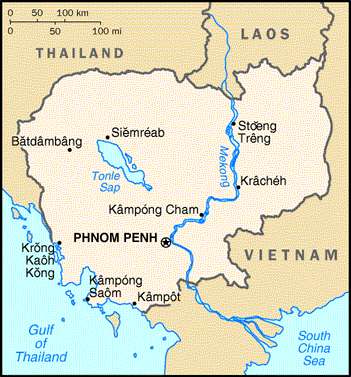

Status Quo Side: Heng Samrin, Vietnamese
Non-Status Quo Side: Khmer Rouge, Sihanouk, Serei
Region: Pacific, East Asia & SE Asia
Conflict Type: External Intervention
Issues in Dispute: Governance, Strategic
Maps: UTexas Cambodia maps
[Cambodia
political 1997]
[Cambodia
shaded relief 1997]
[Cambodia
shaded relief 1991]
This case has no Phase 1 because it centers on the Vietnamese invasion of Cambodia, whereas the immediately prior history of Cambodia was one of internal genocide by the Khmer Rouge under Pol Pot and, just prior to that, of growing civil war ancillary to the larger war in Vietnam between the United States and the Vietcong. A Phase 1 for the present case, including the appropriate sides and issues, could not be directly drawn from those immediately preceding conflicts.
The Vietnam-backed Heng Samrin regime now controlled Phnom Penh and most of Cambodia east of Thailand. Skirmishes continued along the border. Cambodia faced famine from agricultural disruption and near anarchy. By October 280,000 tons of food aid had arrived from the USSR and Vietnam, and 2,000 tons from the West. A large US aid program was targeted at border camps. With food from Western donors going to refugee populations and direct military aid from China, the Khmer Rouge regrouped on the Thai border. Western support fostered smaller anti-communist movements, the two largest led by Son Sann (Serei) and Prince Sihanouk. These 3 opposition groups, under pressure from the US and ASEAN, formed an unstable alliance against the Heng regime in February 1981.
A pattern emerged over the next decade of hostilities during the December-April dry season, and retrenchment during the wet season. Viet attacks were particularly heavy in 1981 and 1983-85. In the late 1980s, the Khmer Rouge began to strike deeper into Cambodia. Periodic talks under UN, ASEAN, and French auspices failed over the issue of Khmer Rouge and Heng regime participation in any future government.
As some Vietnamese troops withdrew and US-USSR relations improved, the US in July 1990 abandoned its opposition to the Vietnam-installed regime. At Djarkata in September the parties tentatively committed to peace and to elections under UN supervision. In May 1991 the four combatants agreed to a cease-fire sponsored by France and the UNSYG. On October 23 the Paris Agreement called for a 70 per cent reduction in armies, with remaining weapons surrendered to UN peacekeepers; joint interim governance including all factions; and a UN Transition Authority (UNTAC) subsequently funded at $1.9 billion, to prepare for UN-supervised elections. Persistent Khmer Rouge violations of the agreement including refusal to demobilize, prompted UN-imposed trade sanctions on November 30,1992. The Khmer Rouge took no part in the UN-monitored May 1993 elections which brought to power the Royal Government of Cambodia. Cambodia remained divided between government zones and autonomous KR zones. Fighting continued propelling 30,000 refugees into Thailand. North Korea sponsored a round-table conference on "peace and national reconciliation" in May 1994, which led to a six-month amnesty for Khmer Rouge members. Several thousands defected, although a hard-core of 5-10,000 remained. Meanwhile the dual government of Hun Sen and Norodom Ranariddh broke down. In February, 1998 the rival factions signed a truce and in June the UN agreed to monitor elections scheduled for July. In April KR leader Pol Pot, responsible for mass murder of his people in the 1970s, died.